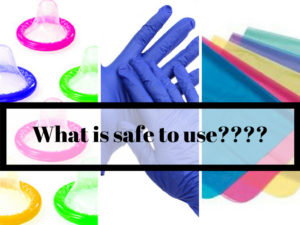If you have ever googled “Can I use plastic wrap for oral sex,” you’ve found that there are a lot of articles from reliable sources stating that you should NOT use microwave safe plastic wrap as a dental dam. These articles claim that microwave-safe plastic wrap has “pores” in it to let the steam escape when used on food in the microwave, making it easy for viruses to travel through the plastic wrap as well.
This myth has caught on in the sex education community and 90% of the educators I know are sharing this misleading information.

Myth busting time: microwave-safe plastic wrap is an acceptable dental dam substitute. It has no more pores in it than its non microwave safe cousin.
The history of plastic wrap tells a logical story of how this myth came about. The original saran wrap was made of Polyvinyliden dichloride (PVDC) which was discovered at Dow Chemical in 1933. PVDC has low permeability to water vapor, flavor and aroma molecules, so it slowed food spoilage while keeping flavors fresh. PVDC is not naturally flexible, so saran wrap has plasticizers added to it in order to make it into the wrap-able film we know and love.
Unfortunately PVDC has a tendency to leach plasticizers into our food when it’s heated, so it’s not considered “microwave safe.” PVDC was mostly phased out by manufacturers in favor of low density or very low density polyethylene (LDPE or LLDPE) wrap, which is cheaper and easier to process than PVDC. It also doesn’t leach plasticizers when heated!
Because almost all plastic wraps sold in grocery stores now are made with polyethylene, you’re hard pressed to find a non microwave-safe plastic wrap for retail sale. If you noticed in the mid-90’s that suddenly your plastic wrap was a lot less sticky than before, this change in manufacturing material is why.
But does fact alone mean plastic wrap can be for oral sex? Maybe.
I wanted to take a deeper dive into the material data for different types of plastic wraps to see how they really stack up against condoms, dental dams, and gloves, all of which can be used for oral sex. My question: just how impermeable are all of these materials?
Plastic wrap can be made of 3 different materials:
- Low density polyethylene
- Linear low density (ie very low density) polyethylene
- Vinyl chloride and vinylidene mix (the “food safe” remake of PVDC)
I’ll compare this with condoms made of:
- ISO 4074, Natural latex rubber
- Polyurethane
Dental Dams made of:
- Latex rubber
- *polyurethane dams are also manufactured, but we can extrapolate similar data from polyurethane condoms which are more widely studied*
and single-use exam gloves (.1 and .15 mm thick) made of:
- Latex
- Nitrile (synthetic rubber)
There is almost no data out there on how plastic wraps stand up to the mechanical stress of sex, nor its permeability to vaginal fluid. But what we do have is water vapor permeability data—a lot of it—for all different varieties of plastic compounds.
When condom companies test the integrity of their product, they use a test particle of 27 nanometeres wide, designed to mimic the smallest STI, Hepatitis B (also 27 nanometers in diameter). Most STIs are much larger than this. HIV, for comparison, is 120 nanometers across. Water molecules, however, are less than 1 nanometer across. If water can’t get through our barriers, then neither will any STIs.
The folks from Partners In Sex Education did a really fun at home science experiment to demonstrate this principle with one variety of plastic wrap in a youtube video here.
| Material | Thickness | Water Permeability[1] |
| Low Density Polyethylene (plastic wrap) | .025 mm
|
.5- .74 g • mm/ meters2 |
| Linear Low Density Polyethylene (plastic wrap) | .025 mm
|
.28 g • mm/ meters2 permeability |
| Vinyl chloride and vinylidene mix (PVDC, version 2.0) | Multiple thicknesses | .02- .13 g• mm/ meters2 |
| Polyurethane (condoms) | Multiple thicknesses | .04- 3.43 g x mm/meter2
|
| Natural Latex (condoms) | .048 mm (ultra thin) | .0007 g/condom
***using 27 nm challenge particle, NOT water*** |
[1] Permeability Properties of Plastics and Elastomers : A Guide to Packaging and Barrier Materials
But what do these numbers mean? Our highest amount of water permeability comes from low density polyethylene, at .74 grams of water (1 gram = 1 mL) per meter squared. That’s the equivalent of about 1/8th of a teaspoon of water spread over a square meter of plastic wrap, under constant tension from water vapor for a full 24 hours.
The natural latex used in condoms is many times more effective, allowing only .0007 g/condom through, but the particle being measured is a 27 nanometer “challenge particle” and not water (again, remember water is only 1 nanometer wide).
The main advantage to condoms however, is their relative thickness. Plastic wrap is exceedingly thin, usually between .01 and .025 milimeters in thickness. Condoms, even at their thinnest, run about .048 mm thick. With all material, permeability is not just a function of the chemical composition of a compound, but the number of times those molecules are layered over each other.
Glyde dental dams, also made of latex rubber, run about .07mm in thickness, almost three times as thick as plastic wrap. Latex and nitrile exam gloves are even thicker than that, between .1 and .15 mm thick.
The tradeoff with STI barriers is often sensation versus security. Barriers like condoms, dental dams, and latex gloves are highly effective at keeping fluid and viruses out, but they come with a dampening of sensation for oral sex. Plastic wrap meets a friendly compromise between the two by offering a very thin substance with good heat and sensation transference while remaining largely impermeable to fluid.
Is that Good Enough?
Anyone who has taken a microbiology or epidemiology class has heard the phrase “The Dose Makes the Poison,” meaning the amount of a dangerous substance is just as important as what the substance is. For instance, if you swab any surface of your house, you’re likely to find a few e. coli bacteria. And yet, the entire country is not in the midst of an e. coli epidemic.
That’s because our innate immune systems have the ability to handle small doses of otherwise deadly substances. There aren’t enough e. coli bacteria on my bathroom faucet to effectively colonize inside my body and give me an infection.
Likewise, when we talk about permeability of materials by water vapor, and by extension, the fluids, bacteria, and viruses of sex, we don’t need to speak in absolutes. Every material we test will have some permeability to water, because of the tiny size of its molecules.
With a worst case scenario level, plastic wrap allows 1/8th of teaspoon of water permeability per use. Let’s extrapolate down from there.

The Bottom Line
Depending on your level of comfort with risk, the strength of your immune system, and what materials are physically and financially accessible to you, plastic wrap is a pretty safe option for oral sex. We don’t have the controlled testing data to authoritatively assess these materials for their safety and efficacy, but hopefully this article gives you a general framework that you can use to make an informed decision for your body and your life.




